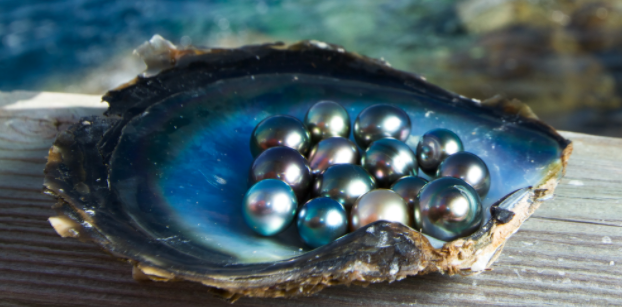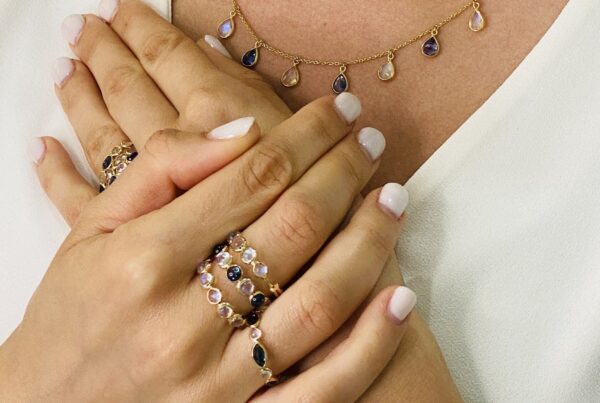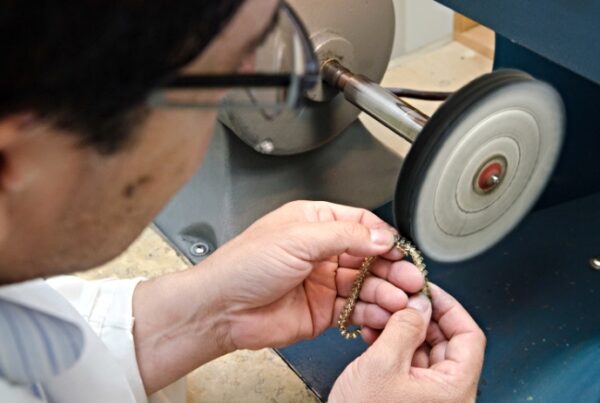Pearl – Nature’s Treasure from the Sea
Pearls are one of nature’s most exquisite gemstones. They are the only gems created from organic, living creatures – the pearl oyster. They have a unique depth of color that is both iridescent and lustrous, and they are warm to the touch. From the time of their first discovery, pearls have never lost their fascination or desirability. Here are some facts about this treasure from the sea.
What Makes A Pearl
Pearls are formed in the bodies (called mantel tissue) of certain species of oysters. When an irritant is lodged in its body tissue, the oyster secretes a mother-of-pearl nacre wraps around the irritant. The end result of this nacre wrap is a pearl. Naturally occurring pearls are extremely rare and costly.
Cultured Pearls
Created through human intervention, cultured pearls provide 95% of the world’s inventory. In Japan, Kokichi Mikimoto developed the process of cultivating pearls in 1893. A cultured pearl is created by inserting a single shell bead and some mantel tissue into a host oyster. The mantel tissue used is from another oyster that has produced high quality pearls.
There are four major types of cultured whole pearls:
Akoya— Akoya pearls have the best luster and are produced mainly in Japan and China.
South Sea— The leading sources of these saltwater cultured pearls are Australia, Indonesia, and the Philippines. South Sea pearls are white or golden in color and range in size from 10mm to 20mm. These pearls command high prices because of their exceptional size and rarity.
Tahitian— These pearls are cultivated primarily around the islands of French Polynesia, with the most familiar being Tahiti. They are deeply hued in a range of peacock-like colors. Some of the deepest in tone are called Black Tahitian pearls.
Freshwater—These are usually cultured in freshwater lakes and ponds. They’re produced in a wide range of sizes, shapes, and colors. China and the U.S. are the leading sources of freshwater pearls.
Natural Pearls
Naturally occurring pearls are extremely rare. They have been found in the Persian Gulf waters near Bahrain, as well as off the coasts of Australia. Australia owns one of the world’s last remaining natural pearl diving fleets located in the Indian Ocean. India is recognized as one of the last producers and handlers of naturally occurring pearls.
Pearl Qualities
Pearls are very soft, ranging between 2.5 and 4.5 on the Mohs scale. They are sensitive to extreme heat and acidity; in fact, calcium carbonate is so susceptible to acid that pearls will dissolve in vinegar.
Pearls are one of few gems not measured by carats.
The overall value of a pearl is determined by its size, shape, color, luster, surface quality, and nacre. When multiple pearls are used in jewelry making, pearls well-matched in color and size are the most valuable.
When other value factors are equal, larger pearls are the most valuable because they are so rare. Round is the most difficult shape to culture, making this pearl shape the most valuable. Pearl lovers also prize pearls that are pear-shaped, oval, or baroque (irregularly shaped.) Mabe pearls have a half-pearl blister shape and most often used for earrings and rings.
Both natural and cultured pearls occur in a broad range of hues from warm colors to cool. There tone can range from light to dark. Pearls are known for their soft and muted coloration.
Reflective luster is often considered the most important pearl quality. Luster is what gives a natural or cultured pearl its unique beauty. It provides an iridescent rainbow of colors just below the pearl surface. The finest pearls are metallic in color and reflective like mirrors.
A good surface is smooth and without any visible-to-the-eye blemishes.
Nacre is a pearl’s exterior coating. Thick nacre makes a pearl more lustrous and beautiful, as well as more durable.
Luster Rating
Excellent – Reflections appear bright and sharp
Very Good – Reflections appear bright and near sharp
Good – Reflections are bright but not sharp, and slightly hazy around the edges
Fair – Reflections are weak and blurred
Poor – Reflections are dim and diffused
History
The name “pearl” comes from the Old French perle, from the Latin perna meaning “leg,” referencing the leg-of-mutton shape of an open mollusk shell.
Pearls have been used as adornment as far back as ancient Greece. They were believed to be tears of the gods. Ancient Egyptians were often buried with their pearls.
The oldest known pearl jewelry was discovered in the sarcophagus of a Persian Princess who died in 520 B.C. During the Byzantine Empire, only the reigning emperor was allowed to wear pearls. Pearls were extremely popular with royalty in Tudor England.
The pearl is one of three birthstones for the month of June. The other two are alexandrite and moonstone. The pearl is also the birthstone for babies born under the signs of Gemini and Cancer. Brides traditionally wear pearls on their wedding day as a symbol of purity and innocence. Pears are also considered n appropriate a gift for the 1st, 3rd, 12th, and 30th wedding anniversaries.
Real or Fake?
Imitation pearls or shell pearls are made from conch shells or glass coated with a solution containing fish scales. Rubbing two pearls together will reveal if they are smooth imitation stones, or if they feel gritty from the nacre that comprises natural and cultured pearls. Natural pearls consist entirely of concentric growth rings, while cultured pearls have a solid nucleus. Gem experts have equipment to distinguish natural from cultured pearls.
The pearl is truly a unique and beautiful gem from the ocean.








